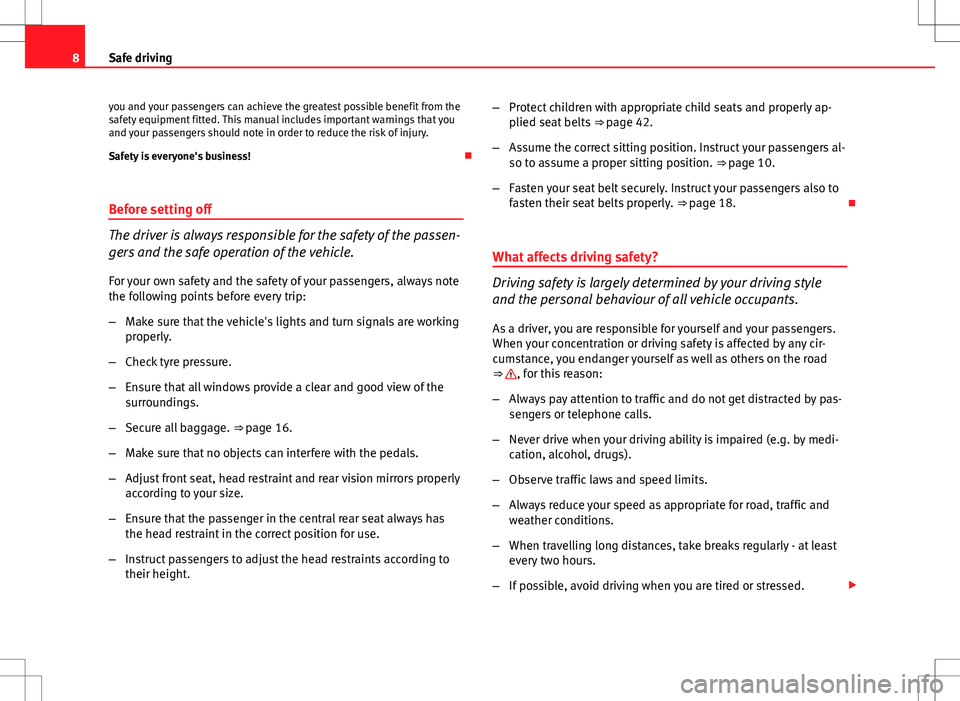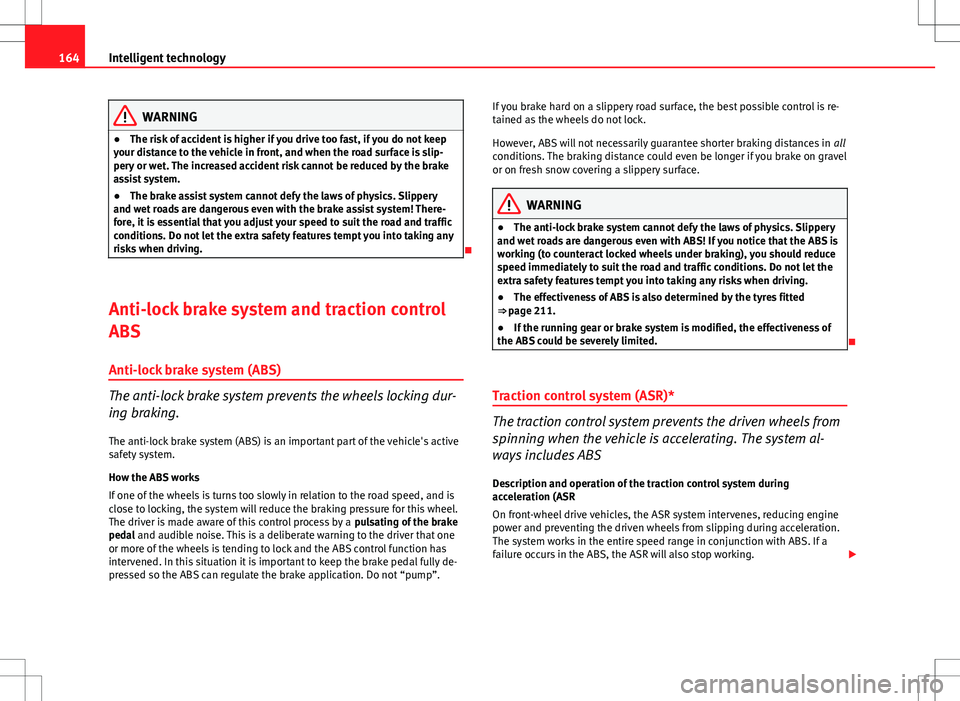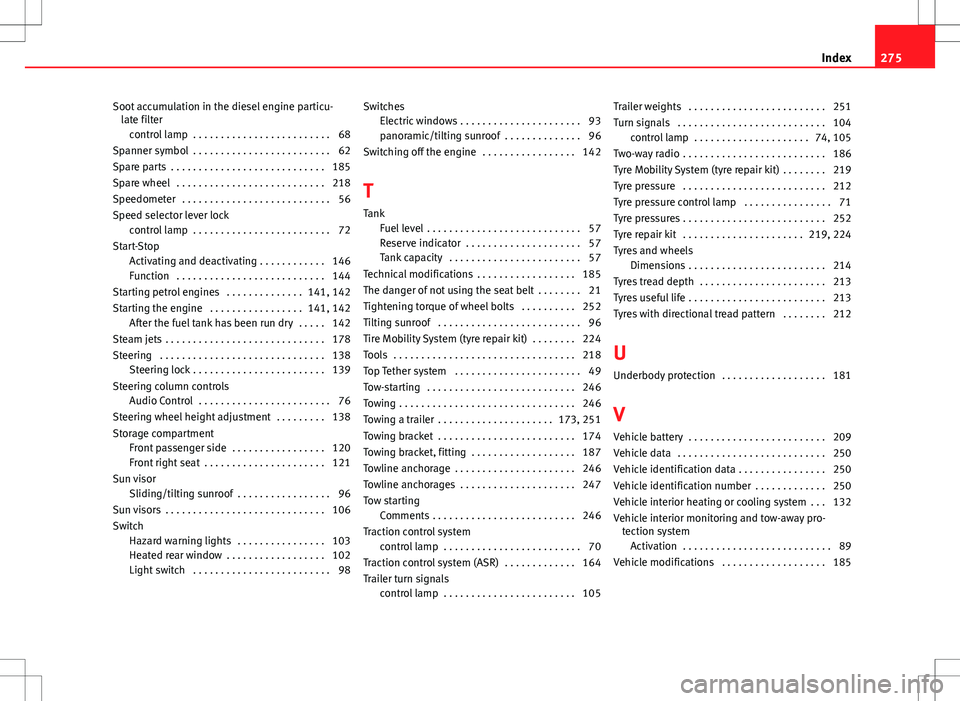2012 Seat Ibiza 5D tire pressure
[x] Cancel search: tire pressurePage 10 of 280

8Safe driving
you and your passengers can achieve the greatest possible benefit from the
safety equipment fitted. This manual includes important warnings that you
and your passengers should note in order to reduce the risk of injury.
Safety is everyone's business!
Before setting off
The driver is always responsible for the safety of the passen-
gers and the safe operation of the vehicle.
For your own safety and the safety of your passengers, always note
the following points before every trip:
– Make sure that the vehicle's lights and turn signals are working
properly.
– Check tyre pressure.
– Ensure that all windows provide a clear and good view of the
surroundings.
– Secure all baggage. ⇒ page 16.
– Make sure that no objects can interfere with the pedals.
– Adjust front seat, head restraint and rear vision mirrors properly
according to your size.
– Ensure that the passenger in the central rear seat always has
the head restraint in the correct position for use.
– Instruct passengers to adjust the head restraints according to
their height. –
Protect children with appropriate child seats and properly ap-
plied seat belts ⇒ page 42.
– Assume the correct sitting position. Instruct your passengers al-
so to assume a proper sitting position. ⇒ page 10.
– Fasten your seat belt securely. Instruct your passengers also to
fasten their seat belts properly. ⇒ page 18.
What affects driving safety?
Driving safety is largely determined by your driving style
and the personal behaviour of all vehicle occupants.
As a driver, you are responsible for yourself and your passengers.
When your concentration or driving safety is affected by any cir-
cumstance, you endanger yourself as well as others on the road
⇒
, for this reason:
– Always pay attention to traffic and do not get distracted by pas-
sengers or telephone calls.
– Never drive when your driving ability is impaired (e.g. by medi-
cation, alcohol, drugs).
– Observe traffic laws and speed limits.
– Always reduce your speed as appropriate for road, traffic and
weather conditions.
– When travelling long distances, take breaks regularly - at least
every two hours.
– If possible, avoid driving when you are tired or stressed.
Page 166 of 280

164Intelligent technology
WARNING
● The risk of accident is higher if you drive too fast, if you do not keep
your distance to the vehicle in front, and when the road surface is slip-
pery or wet. The increased accident risk cannot be reduced by the brake
assist system.
● The brake assist system cannot defy the laws of physics. Slippery
and wet roads are dangerous even with the brake assist system! There-
fore, it is essential that you adjust your speed to suit the road and traffic
conditions. Do not let the extra safety features tempt you into taking any
risks when driving.
Anti-lock brake system and traction control
ABS Anti-lock brake system (ABS)
The anti-lock brake system prevents the wheels locking dur-
ing braking.
The anti-lock brake system (ABS) is an important part of the vehicle's active
safety system.
How the ABS works
If one of the wheels is turns too slowly in relation to the road speed, and is
close to locking, the system will reduce the braking pressure for this wheel.
The driver is made aware of this control process by a pulsating of the brake
pedal and audible noise. This is a deliberate warning to the driver that one
or more of the wheels is tending to lock and the ABS control function has
intervened. In this situation it is important to keep the brake pedal fully de-
pressed so the ABS can regulate the brake application. Do not “pump”. If you brake hard on a slippery road surface, the best possible control is re-
tained as the wheels do not lock.
However, ABS will not necessarily guarantee shorter braking distances in
all
conditions. The braking distance could even be longer if you brake on gravel
or on fresh snow covering a slippery surface.
WARNING
● The anti-lock brake system cannot defy the laws of physics. Slippery
and wet roads are dangerous even with ABS! If you notice that the ABS is
working (to counteract locked wheels under braking), you should reduce
speed immediately to suit the road and traffic conditions. Do not let the
extra safety features tempt you into taking any risks when driving.
● The effectiveness of ABS is also determined by the tyres fitted
⇒ page 211.
● If the running gear or brake system is modified, the effectiveness of
the ABS could be severely limited.
Traction control system (ASR)*
The traction control system prevents the driven wheels from
spinning when the vehicle is accelerating. The system al-
ways includes ABS
Description and operation of the traction control system during
acceleration (ASR
On front-wheel drive vehicles, the ASR system intervenes, reducing engine
power and preventing the driven wheels from slipping during acceleration.
The system works in the entire speed range in conjunction with ABS. If a
failure occurs in the ABS, the ASR will also stop working.
Page 277 of 280

Soot accumulation in the diesel engine particu-late filter
control lamp . . . . . . . . . . . . . . . . . . . . . . . . . 68
Spanner symbol . . . . . . . . . . . . . . . . . . . . . . . . . 62
Spare parts . . . . . . . . . . . . . . . . . . . . . . . . . . . . 185
Spare wheel . . . . . . . . . . . . . . . . . . . . . . . . . . . 218
Speedometer . . . . . . . . . . . . . . . . . . . . . . . . . . . 56
Speed selector lever lock control lamp . . . . . . . . . . . . . . . . . . . . . . . . . 72
Start-Stop Activating and deactivating . . . . . . . . . . . . 146
Function . . . . . . . . . . . . . . . . . . . . . . . . . . . 144
Starting petrol engines . . . . . . . . . . . . . . 141, 142
Starting the engine . . . . . . . . . . . . . . . . . 141, 142 After the fuel tank has been run dry . . . . . 142
Steam jets . . . . . . . . . . . . . . . . . . . . . . . . . . . . . 178
Steering . . . . . . . . . . . . . . . . . . . . . . . . . . . . . . 138 Steering lock . . . . . . . . . . . . . . . . . . . . . . . . 139
Steering column controls Audio Control . . . . . . . . . . . . . . . . . . . . . . . . 76
Steering wheel height adjustment . . . . . . . . . 138
Storage compartment Front passenger side . . . . . . . . . . . . . . . . . 120
Front right seat . . . . . . . . . . . . . . . . . . . . . . 121
Sun visor Sliding/tilting sunroof . . . . . . . . . . . . . . . . . 96
Sun visors . . . . . . . . . . . . . . . . . . . . . . . . . . . . . 106
Switch Hazard warning lights . . . . . . . . . . . . . . . . 103
Heated rear window . . . . . . . . . . . . . . . . . . 102
Light switch . . . . . . . . . . . . . . . . . . . . . . . . . 98 Switches
Electric windows . . . . . . . . . . . . . . . . . . . . . . 93
panoramic/tilting sunroof . . . . . . . . . . . . . . 96
Switching off the engine . . . . . . . . . . . . . . . . . 142
T Tank Fuel level . . . . . . . . . . . . . . . . . . . . . . . . . . . . 57
Reserve indicator . . . . . . . . . . . . . . . . . . . . . 57
Tank capacity . . . . . . . . . . . . . . . . . . . . . . . . 57
Technical modifications . . . . . . . . . . . . . . . . . . 185
The danger of not using the seat belt . . . . . . . . 21
Tightening torque of wheel bolts . . . . . . . . . . 252
Tilting sunroof . . . . . . . . . . . . . . . . . . . . . . . . . . 96
Tire Mobility System (tyre repair kit) . . . . . . . . 224
Tools . . . . . . . . . . . . . . . . . . . . . . . . . . . . . . . . . 218
Top Tether system . . . . . . . . . . . . . . . . . . . . . . . 49
Tow-starting . . . . . . . . . . . . . . . . . . . . . . . . . . . 246
Towing . . . . . . . . . . . . . . . . . . . . . . . . . . . . . . . . 246
Towing a trailer . . . . . . . . . . . . . . . . . . . . . 173, 251
Towing bracket . . . . . . . . . . . . . . . . . . . . . . . . . 174
Towing bracket, fitting . . . . . . . . . . . . . . . . . . . 187
Towline anchorage . . . . . . . . . . . . . . . . . . . . . . 246
Towline anchorages . . . . . . . . . . . . . . . . . . . . . 247
Tow starting Comments . . . . . . . . . . . . . . . . . . . . . . . . . . 246
Traction control system control lamp . . . . . . . . . . . . . . . . . . . . . . . . . 70
Traction control system (ASR) . . . . . . . . . . . . . 164
Trailer turn signals control lamp . . . . . . . . . . . . . . . . . . . . . . . . 105 Trailer weights . . . . . . . . . . . . . . . . . . . . . . . . . 251
Turn signals . . . . . . . . . . . . . . . . . . . . . . . . . . . 104
control lamp . . . . . . . . . . . . . . . . . . . . . 74, 105
Two-way radio . . . . . . . . . . . . . . . . . . . . . . . . . . 186
Tyre Mobility System (tyre repair kit) . . . . . . . . 219
Tyre pressure . . . . . . . . . . . . . . . . . . . . . . . . . . 212
Tyre pressure control lamp . . . . . . . . . . . . . . . . 71
Tyre pressures . . . . . . . . . . . . . . . . . . . . . . . . . . 252
Tyre repair kit . . . . . . . . . . . . . . . . . . . . . . 219, 224
Tyres and wheels Dimensions . . . . . . . . . . . . . . . . . . . . . . . . . 214
Tyres tread depth . . . . . . . . . . . . . . . . . . . . . . . 213
Tyres useful life . . . . . . . . . . . . . . . . . . . . . . . . . 213
Tyres with directional tread pattern . . . . . . . . 212
U Underbody protection . . . . . . . . . . . . . . . . . . . 181
V
Vehicle battery . . . . . . . . . . . . . . . . . . . . . . . . . 209
Vehicle data . . . . . . . . . . . . . . . . . . . . . . . . . . . 250
Vehicle identification data . . . . . . . . . . . . . . . . 250
Vehicle identification number . . . . . . . . . . . . . 250
Vehicle interior heating or cooling system . . . 132
Vehicle interior monitoring and tow-away pro- tection system
Activation . . . . . . . . . . . . . . . . . . . . . . . . . . . 89
Vehicle modifications . . . . . . . . . . . . . . . . . . . 185
275
Index